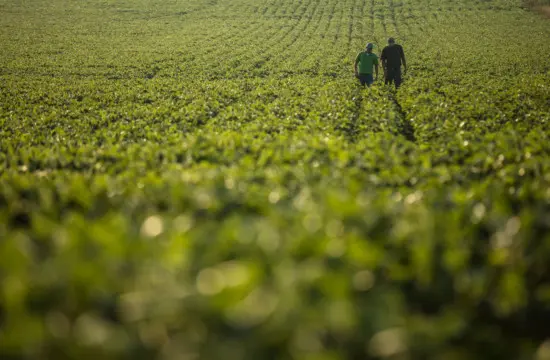What is Crop Rotation?
Crop rotation is like the farmer’s version of Sudoku in that it involves strategy, expert placement, and zero guessing to yield healthy crops with the most cost-effective and environmentally friendly results. Crop rotation charts reveal a planting method of switching out crops every season in a revolving door-like fashion over the course of three to ten-year periods. Other benefits of crop rotation include decreasing pests, weeds, and harmful pathogens by frequently disrupting their environment.
A four-year crop rotation chart, for instance, may start with legumes, then move to root vegetables, fruits, and leafy greens to help create healthier microbe levels in the soil. Crop rotation is not as simple as blindly picking crops to plant and subsequently harvest each season. Instead, it involves a deeper level of skill and a precious balance of the nitrogen levels in the soil. Crop rotation can also incorporate livestock grazing where animals like sheep and cows graze particular areas. This improves soil organic matter and boosts the amount of water soil retains, proving advantageous for plants and crops to grow (especially in areas with less rainfall).
As each plant interacts with the soil in very different ways, it makes sense to implement crop rotation to ensure the soil retains the optimal level of nutrients. For example, peppers and tomatoes draw an abundant amount of nitrogen from the soil. To combat this issue, the next season a farmer might plant a nitrogen-fixing crop like soybean to restore a balanced nitrogen level. Crop rotation can take years to complete a full cycle where the first crop originally planted in one plot of land will not be planted in the same plot for several years. As crops can still grow on the same plot of land year after year, it begs the question—why is crop rotation important? Keep reading to discover all of the benefits of crop rotation and why farmers have been using this practice since 6000 BC.
Why Is Crop Rotation Important?
To answer this question, it’s best to look at real-world examples. For instance, one of the reasons it’s illegal to bring unsealed food into the U.S. is because fruit, rice, and other foods can harbor potentially harmful pathogens. Pathogens cause diseases in plants and can be especially dangerous to those with weakened immune systems. As particular pathogens are fond of specific crops, continuous cropping (a technique where crops are planted in the same plot of land that they previously inhabited) can lead to a quick rise in soil-borne pathogen levels. To solve this issue, farmers can implement crop rotation which naturally disrupts the spread of disease by planting a crop that is not a host for that specific pathogen.
By now, we hope you’ve walked away with more answers to the question, “why is crop rotation important?” But if not, allow us to explain further. Just as braiding the same hairstyle on your head day after day would lead to damaged hair, so too can planting the same crop in the soil season after season leads to poor quality soil. Soil is a living, breathing organism and requires care. Crop rotation gives the soil a break from rooting patterns when you change the crops that get planted, as some crops have deep roots and others have shallow ones. To increase soil’s microbial diversity, farmers can rotate crops that have high nitrogen and carbon amounts with ones with opposite ratios. On top of this, crop rotation with peas and chickpeas can produce higher wheat yields the following season. Plus, research has shown that different crops can create root exudes (organic fluids secreted by plant roots) to increase soil microbial diversity and biomass.
Benefits of Crop Rotation
1. Enhance Soil Structure
Plant growth can be inhibited by soil compaction, which is when the pores in soil are pressed so tightly together that they leave little room for water and nutrients to reach a plant’s root, killing the plant. Soil compaction can be caused by walking on top of the soil or using heavy farming equipment across it. Crop rotation improves soil’s physical texture by rotating different plants whose roots reach various soil depths instead of leaving the soil in its compressed state. Poor soil structure will result in hormonal signals being sent to slow down the growth of a plant’s shoot even if they can physically access water and nutrients. This survival-like mechanism is the soil’s response to preservation so more nutrients can infiltrate the soil. If crop rotation isn’t implemented, the plant can still suffer regardless.
2. Boost Soil Fertility
Continuous planting can decrease vital nutrients in the soil. Crop rotation can revitalize soil by putting some of those lost nutrients back into the ground. For instance, certain crops can increase potassium levels in the soil, which can then be used by peas or corn (which require higher levels of potassium to grow). Manure can also be used to improve soil fertility and bacterial diversity levels by enriching soil better than inorganic fertilizer. Microorganisms like fungi and earthworms increase in the soil after manure application. These organisms assist the nutrient cycle process, which can be given to plants for increased yield.
3. Prevent Soil Erosion
Nature is unpredictable and heavy rainfall or wind can erode the top layer of soil, impacting crops. Crop rotation with cereal rye, oats, and certain strains of wheat protects topsoil and almost acts as a blanket for crops. These cover crops also provide roots to the soil so they can continue to gain nutrients for optimal conditions. Plants like vetch, rye, and clover can also be used as cover crops. Plants like vetch, rye, and clover can also be used as cover crops.
Soil erosion tends to happen in places like the Midwest where farming is common. Research shows that 60 percent of eroded soil washes away into streams, lakes, and rivers, increasing the chance for further pollution?
4. Decrease Pollution
Crop rotation allows plants to receive optimal nutrients from the soil, which can result in a reduction in fertilizer use – especially if crops are able to effectively utilize the nutrients in and around them. More nutrients in the plant means less in streams and lakes.
5. Prevents the Concentration of Pests and Diseases
Crop rotation is useful to prevent plants succumbing from pests and diseases. Pests and diseases can live in the soil, which is why changing the crops each season can deter them. Certain plants are resistant to pathogens called non-host plants that could be used to assist in limiting the spread of diseases and pests.
6. Reduces Weed Growth
It’s no secret that weeds can wreak havoc on a plant’s life cycle. If you don’t have access to a self-driving robot that shoots lasers, farmers can look to herbicides to destroy weeds. One way to reduce the number of weeds (without farm robots) is by creating less-than-desirable conditions for the weeds through crop rotation. Crop rotation creates a constantly changing environment so weeds have very little time to adapt to the new conditions.
Weeds are opportunistic and seek to steal nutrients from crops and plants. Over time, weeds have become adaptable as some survive with minimal water. Crop rotation allows plenty of crops to grow, and creates less space for weeds to inhabit the soil.
7. Raises Crop Yield
Honestly, this could be the No. 1 listing in this section. Yield is everything. As a farmer, if you don’t have adequate yield, you probably aren’t staying in this job for long. Crop rotation leads to more yield and profitability. Monocropping involves using a field for one type of crop every single year, which can increase pollution and depletes the soil of nutrients. Ditching this practice in favor of crop rotation can create a better return on investment.
One study found a 29 percent improved corn yield compared to continuous cropping when done in a two-year rotation. This yield increased to 48 percent during a four-year crop rotation with the use of a legume cover crop in the winter season for one of the four years. Implementing crop rotation can positively affect farmers’ bottom lines, especially during turbulent times as many family farms continue to struggle financially and take on unsustainable levels of debt.
8. Lower Production Costs and Crop Variety
Food costs are rising due to a variety of external pressures. One of the many crop rotation benefits includes decreased input costs. Crop rotation leads to better soils, fewer weeds, and lower pathogens. According to one survey, farmers who used crop diversity with three or four crops for a period of ten years said they had higher profits and crop yields.
What Should Farmers Consider When Adding New Rotational Crops?
Implementing crop rotation is one way to ensure higher yields, lower input costs, and create less pollution. Though you may feel more confident answering the question “what is crop rotation,” it’s important to review these questions below—before you add a crop to your rotational system.
- What type of soil works best for the crop I am adding?
- What type of climate is necessary for this new crop to grow in (warm or cool season)?
- What are the financial requirements and input costs involved?
- Is this new crop in high demand and will it lead to financial benefits?
- Do you have adequate space for the crop to grow?
- Can you rotate in any small grains to supplement soil erosion?
The good news is there are experts available to assist farmers and growers with their crop rotations or if they just have questions. To make the switch and start protecting the environment, connect with a specialist at Verdesian today.


